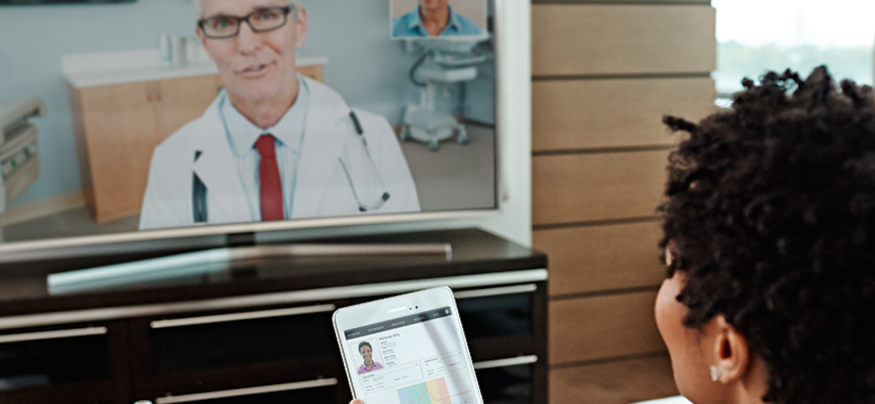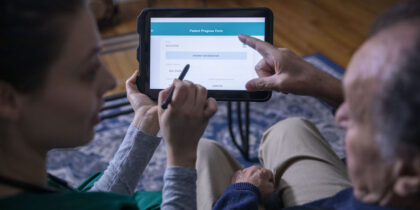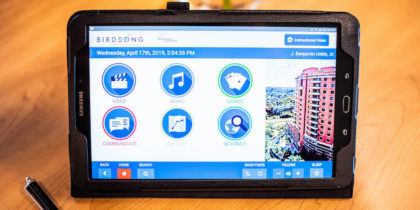Healthcare providers certainly have a stake in keeping patients healthy, but their loved ones have even more on the line. Engaged family members can ensure patients adhere to treatment plans, help them to make informed medical decisions and provide emotional support that speeds recovery and improves outcomes. That’s why innovative healthcare organizations are investing in caregiver technology that makes friends and family part of the medical team.
Keeping Loved Ones in the Loop
Homecare Homebase, a software provider for home health and hospice agencies, understands the importance of family involvement in patient care. In fact, the company’s caregiver technology platform, Family Link, was inspired by one executive’s personal experience.
When the grandmother of Tom Maxwell, the chief strategy officer at Homecare Homebase, needed home health services, he wanted a way to monitor and track her treatment as well as to help her manage her disease. “I would call my family and ask what the home health nurse had to report, and they would simply say, ‘Nana is fine,'” says Maxwell. “Then I’d find out Nana had pain and her blood pressure was up, but no one could tell me how high or how the doctor planned to correct this problem. I wanted to be involved, and I knew other families felt the same way.”
Inspired by Maxwell’s experience, Homecare Homebase added Family Link to the suite of technology solutions it provides to home healthcare agencies. “Our clinicians use Samsung tablets to do their point-of-care documentation from the patient’s bedside,” says Maxwell. “They’re documenting the medical care provided, patient vital signs, medication regimens and any other vital notes about the patient. Caregiver notes sync up with Family Link, so approved family members can see updates on Nana’s care in a secure, HIPAA-compliant environment. We also share educational materials about how to manage the disease, so family members can help their loved one stay healthy and prevent future complications.”
How Caregiver Technology Pays Off
Patient engagement is a priority across the healthcare industry. According to the American Institutes for Research, engaged healthcare users are more likely to comply with treatment plans and preventative care, and they are less likely to end up in the hospital. In order to increase patient engagement, forward-looking healthcare providers are investing in IT solutions like Family Link. According to the 26th Annual HIMSS Leadership Survey, 72 percent of healthcare leaders say patient considerations — including engagement, satisfaction and quality of care — will have a major impact on their organizations in the next couple of years, and 81 percent believe IT is “a highly strategic tool” that can help improve these key business drivers.
By incorporating caregiver technology like Family Link into their IT solutions, healthcare providers can:
- Improve Health Outcomes
The more patients and engaged family members know about disease progression, treatment plans and prevention measures, the more likely they are to avoid future complications and hospitalization. Maxwell explains that family reinforcement is one of the fastest ways to get — and keep — patients healthy. “Families need to understand the disease process,” he says. “If Nana has congestive heart failure, what are we going to do about it? What are the signs and symptoms to watch out for? What side effects should she expect from her medications? If the pill gives her a metallic taste in her mouth, so she doesn’t like taking it, let’s encourage her to stick with it because that will keep her blood pressure down.” Education and conversations like this lead to better outcomes. - Increase Patient Satisfaction Scores
Healthcare reform made customer satisfaction more important than ever. Not only are happy customers more likely to use a provider’s services and refer their friends, but they also give better ratings on the various assessment and ranking tools that are now becoming more prevalent in the industry. “With all the changes happening from a legislative standpoint, customer satisfaction is now directly tied to how care providers get reimbursed,” says Tricia Collom, vice president of marketing for Homecare Homebase. “High scores lead to higher reimbursement, and excessive hospital admissions lead to fines. So, there’s a push industry-wide to keep people out of the hospital and increase patient satisfaction. Family involvement is one way to make patients feel more connected to care providers, which naturally increases satisfaction.” - Boost Productivity and Reduce Costs
When caregivers and other family members can get all the information they need in one place, home health providers don’t have to field calls from multiple people who have concerns or want updates. According to Maxwell, “This was historically a paper-based system. Nurses would take notes in the field, then come home at night and document everything in the computer, then make phone calls to update patients and family members. Now they can do all of this from their Samsung Galaxy tablets while they’re in the patient’s home.”
Healthcare providers aren’t the only ones who care about their patients’ health and happiness; so do their loved ones. By giving families the tools and information they need to keep each other healthy, organizations can deliver a better “Connected Care” experience — from the doctor’s office all the way to the home.
To learn more about mobile technology for home healthcare, read our latest white paper.







